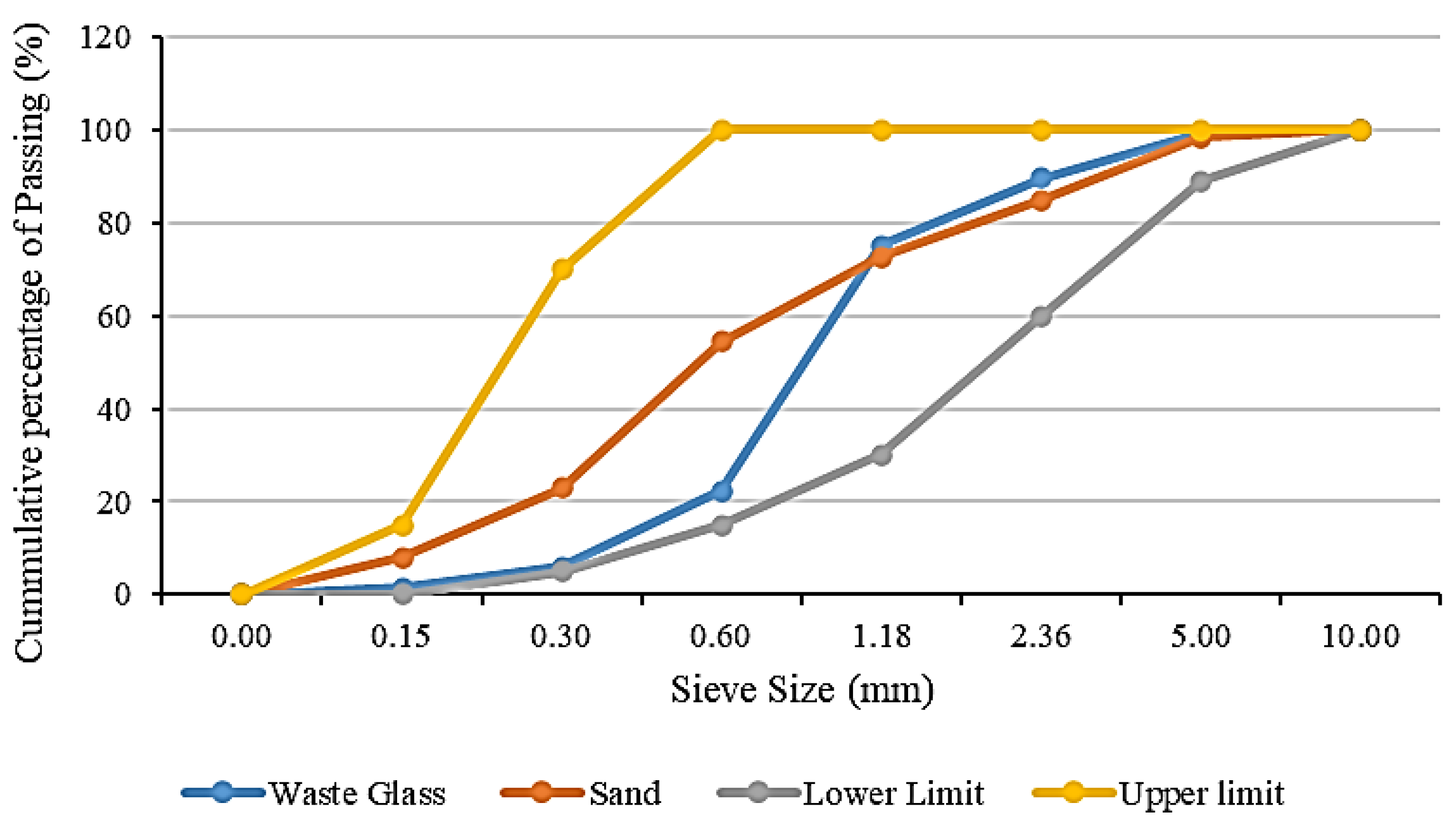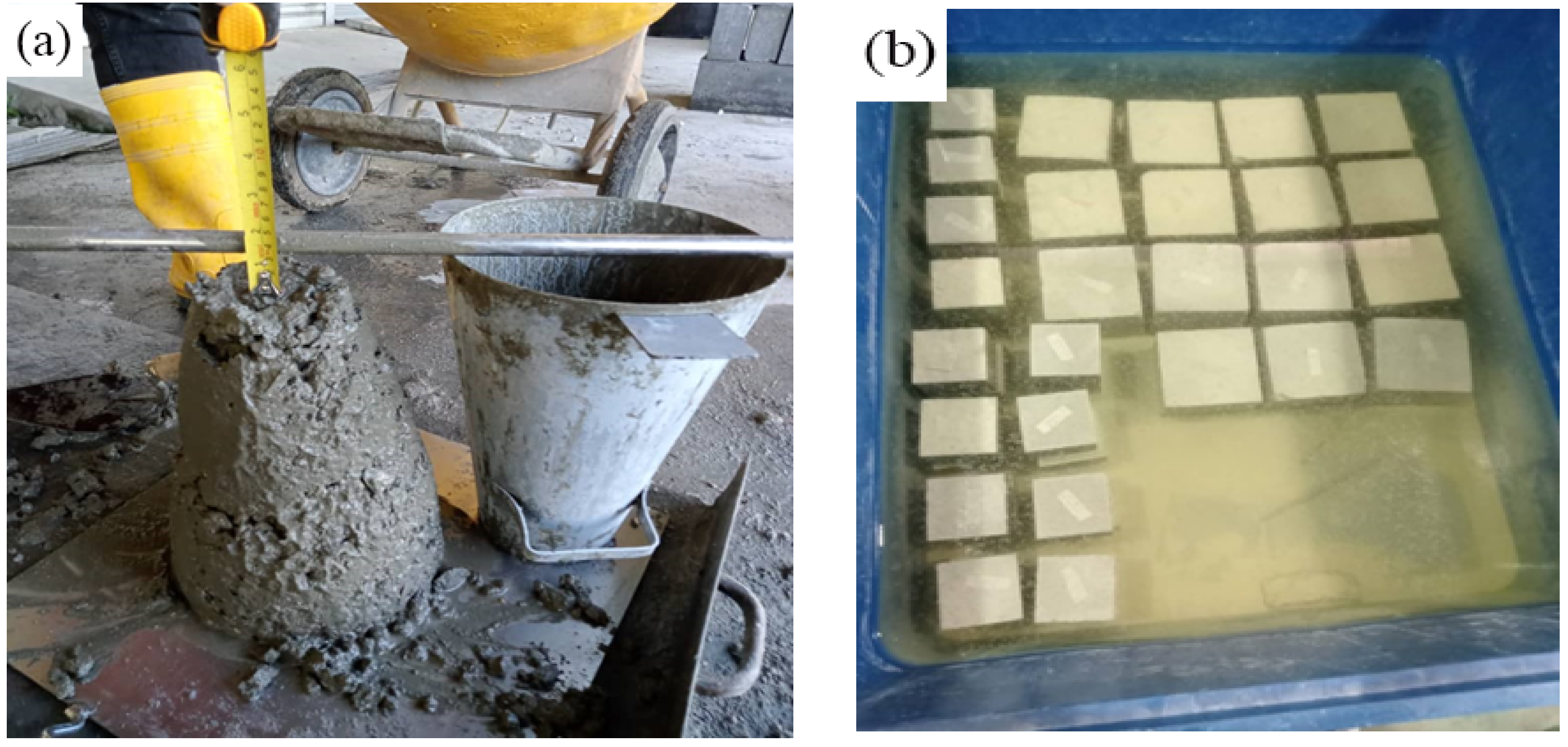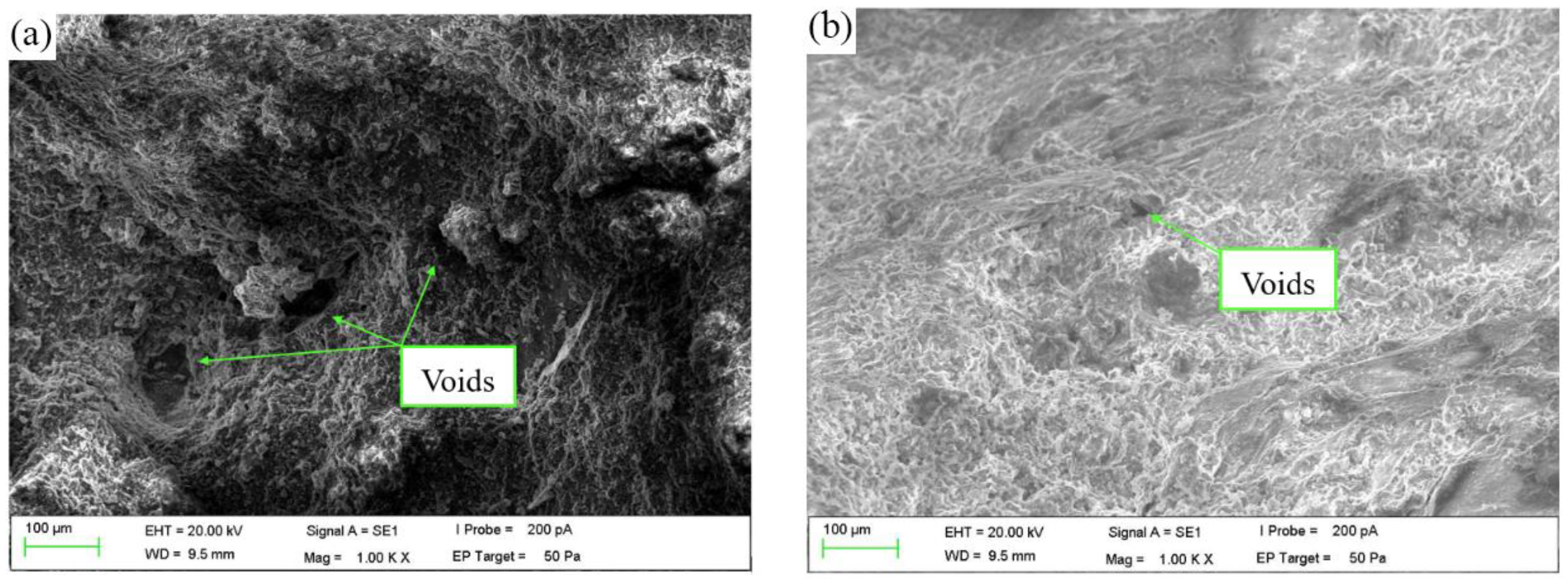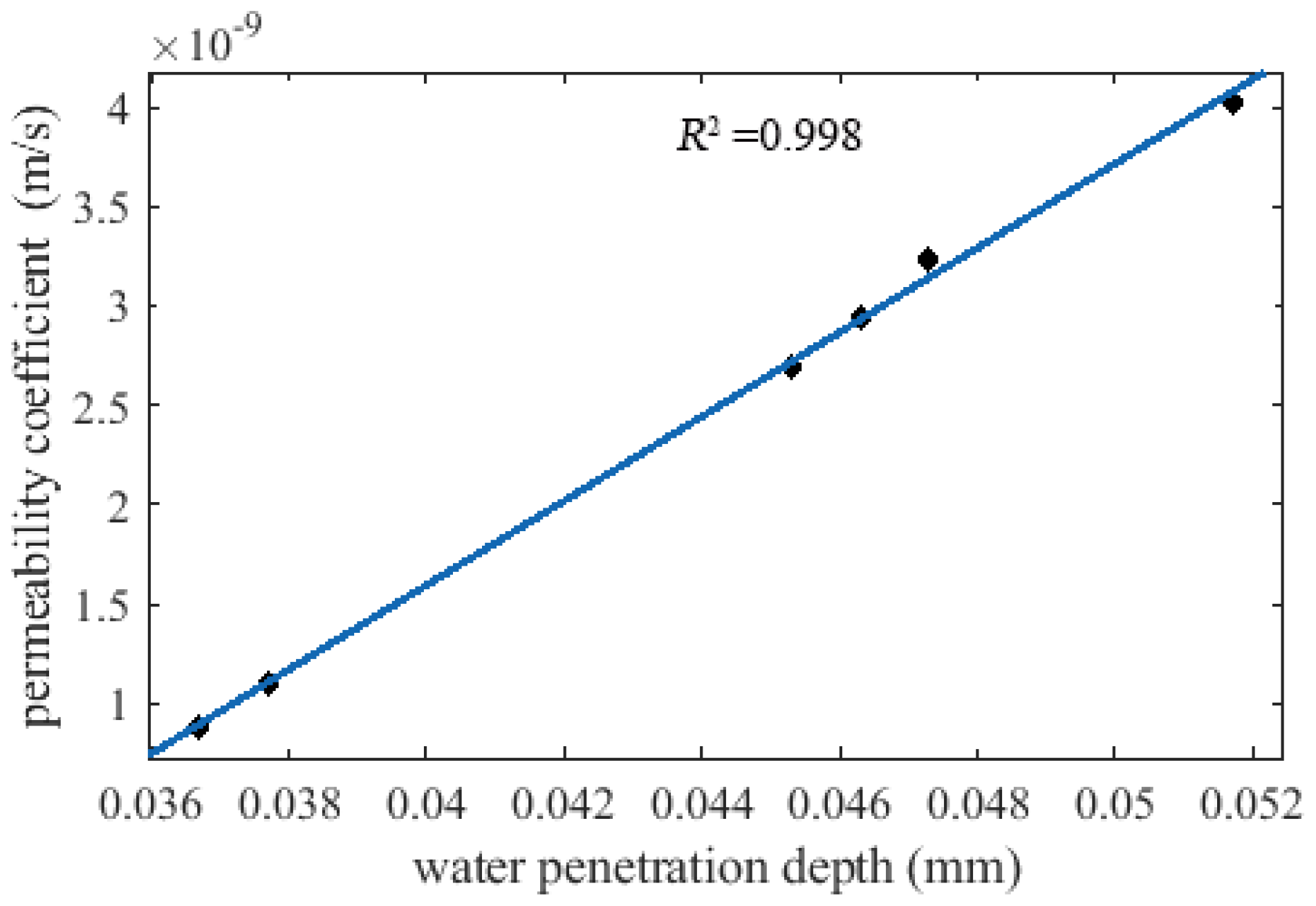Evaluation of Fresh and Hardened Concrete Properties Incorporating Glass Waste as Partial Replacement of Fine Aggregate
Abstract
:1. Introduction
2. Procedure of Experiment
2.1. Materials
2.2. Concrete Mix Proportions
2.3. Hardened Concrete Tests
- K = Coefficient of water permeability (m/s)
- = porosity of concrete
- =
- = Depth of water penetration (m)
- = Hydraulic head (m)
- = Time of test (s)
2.4. Microstructure Test
3. Results and Discussion
3.1. Workability of Concrete
3.2. Density of Concrete
3.3. Compressive Strength of Concrete
3.4. Water Permeability Coefficient of Concrete
3.5. Permability Cofficeient Versus Perntration Depth of Water
4. Conclusions
- The workability of fresh glass-based concrete slightly decreased compared to that of the control concrete (without glass waste). The decrement in workability was attributed to the shape of the GW, which reduced the fluidity of the cement paste. In general, all of the concrete mixes including control and glass-based concrete had acceptable workability between 10 and 30 mm.
- The glass-based concrete exhibited a higher compressive strength (37 MPa) in compression to the control (33.6 MPa), particularly when the replacement percentage increased up to 15%. Such a positive result was attributed to the availability of silica in the glass.
- From the viewpoint of durability, the concrete incorporating 5% of glass waste showed a better performance compared to the control mix. Their water penetration and permeability coefficient were 0.0367, and 0.883 × 10−9 m/s, respectively, while the control mix had 0.0377 and 1.097 × 10−9 m/s.
- It can be said that the incorporation of a lower content of glass waste is a good strategy and sustainable solution for further works. In addition, further concrete properties such as acid resistance and fire resistance should also be investigated.
Author Contributions
Funding
Institutional Review Board Statement
Informed Consent Statement
Data Availability Statement
Acknowledgments
Conflicts of Interest
References
- Algaifi, H.A.; Shahidan, S.; Zuki, S.S.M.; Ibrahim, M.H.W.; Huseien, G.F.; Rahim, M.A. Mechanical properties of coconut shell-based concrete: Experimental and optimisation modelling. Environ. Sci. Pollut. Res. 2022, 29, 21140–21155. [Google Scholar] [CrossRef] [PubMed]
- European Ready Mixed Concrete Organization Association. Ready-Mixed Concrete Industry Statistics; European Ready Mixed Concrete Organization Association: Brussels, Belgium, 2018. [Google Scholar]
- Chilamkurthy, K.; Marckson, A.V.; Chopperia, S.T.; Santhanam, M. A Statistical Overview of Sand Demand in Asia and Europe. In Proceedings of the Case Management Conference, Hong Kong, China, 24 November 2016; pp. 1–16. [Google Scholar]
- UNEP. Sand and Sustainability: Finding New Solutions for Environmental Goverance of Global Sand Resources; United Nations Environment Programme: Geneva, Switzerland, 2020. [Google Scholar]
- Filho, W.L.; Hunt, J.; Lingos, A.; Platje, J.; Vieira, L.W.; Will, M.; Gavriletea, M.D. The Unsustainable Use of Sand: Reporting on a Global Problem. Sustainaility 2021, 13, 3356. [Google Scholar]
- Algaifi, H.A.; Mohamed, A.M.; Alsuhaibani, E.; Shahidan, S.; Alrshoudi, F.; Huseien, G.F.; Bakar, S.A. Optimisation of GBFS, Fly Ash, and Nano-Silica Contents in Alkali-Activated Mortars. Polymers 2021, 13, 2750. [Google Scholar] [CrossRef] [PubMed]
- Mujtaba, H.; Khalid, U.; Farooq, K.; Elahi, M.; Rehman, Z.; Shahzad, H.M. Sustainable utilization of powdered glass to improve the mechanical behavior of fat clay. KSCE J. Civ. Eng. 2020, 24, 3628–3639. [Google Scholar] [CrossRef]
- Paul, D.; Bindhu, K.; Matos, A.M.; Delgado, J. Eco-friendly concrete with waste glass powder: A sustainable and circular solution. Constr. Build. Mater. 2022, 355, 129217. [Google Scholar] [CrossRef]
- Cadore, B.C.; Ribeiro, F.R.C.; Modolo, R.C.E.; Pacheco, F. Performance analysis of concrete with repurposed industrial glass waste. J. Build. Pathol. Rehabil. 2023, 8, 1–13. [Google Scholar] [CrossRef]
- Chen, X.; Chen, H.; Tan, W. Effect of Glass Powder on the Mechanical and Drying Shrinkage of Glass-Fiber-Reinforced Cementitious Composites. Case Stud. Constr. Mater. 2022, 17, e01587. [Google Scholar] [CrossRef]
- Samadi, M.; Shah, K.W.; Huseien, G.F.; Lim, N.H.A.S. Influence of glass silica waste nano powder on the mechanical and microstructure properties of alkali-activated mortars. Nanomaterials 2020, 10, 324. [Google Scholar] [CrossRef] [Green Version]
- Kou, S.C.; Poon, C.S. Properties of self-compacting concrete prepared with recycled glass aggregate. Cem. Concr. Compos. 2009, 31, 107–113. [Google Scholar] [CrossRef]
- Olofinnade, O.M.; Ndambuki, J.M.; Ede, A.N.; Olukanni, D.O. Effect of substitution of crushed waste glass as partial replacement for natural fine and coarse aggregate in concrete. Mater. Sci. Forum 2016, 866, 58–62. [Google Scholar]
- Jin, W.; Meyer, C.; Baxter, S. “Glascrete”-concrete with glass aggregate. ACI Mater. J. 2000, 97, 208–213. [Google Scholar]
- Małek, M.; Łasica, W.; Jackowski, M.; Kadela, M. Effect of waste glass addition as a replacement for fine aggregate on properties of mortar. Materials 2020, 13, 3189. [Google Scholar] [CrossRef] [PubMed]
- Tamanna, N.; Tuladhar, R.; Sivakugan, N. Performance of recycled waste glass sand as partial replacement of sand in concrete. Constr. Build. Mater. 2020, 239, 117804. [Google Scholar] [CrossRef]
- BS 812: Part 103:1985; Testing Aggregates-Part 103: Methods for Determination of Particle Size Distribution. British Standard Institution: London, UK, 1985.
- BS 882:1992; Specification for Aggregates from Natural Sources for Concrete. British Standard Institution: London, UK, 1992.
- Bostanci, S.C. Use of Waste Marble Dust and Recycled Glass for Sustainable Concrete Production. J. Clean. Prod. 2020, 150, 119785–119799. [Google Scholar] [CrossRef]
- BS 1881: Part 125:1986; Testing Concrete- Part 125: Methods for Mixing and Sampling Fresh Concrete in the Laboratory. British Standard Institution: London, UK, 1986.
- BS EN 12390-3:2019; Testing Hardened Concrete-Part 3: Compressive Strength of Test Specimens. British Standard Institution: London, UK, 2019.
- BS EN 12390-2:2000; Testing Hardened Concrete-Part 2: Marking and Curing Specimens for Strength Tests. British Standard Institution: London, UK, 2000.
- Algaifi, H.; Bakar, S.A.; Alyousef, R.; Sam, A.R.; Salami, B.A. Machine learning and RSM models for prediction of compressive strength of smart bio-concrete. Smart Struct. Syst. 2021, 28, 535–551. [Google Scholar]
- Matos, A.M.; Sousa-Coutinho, J. Municipal solid waste incineration bottom ash recycling in concrete: Preliminary approach with Oporto wastes. Constr. Build. Mater. 2022, 323, 126548. [Google Scholar] [CrossRef]
- Mokhtar, N.; Johari, M.A.M.; Tajarudin, H.A.; Al-Gheethi, A.A.; Algaifi, H.A. A sustainable enhancement of bio-cement using immobilised Bacillus sphaericus: Optimization, microstructural properties, and techno-economic analysis for a cleaner production of bio-cementitious mortars. J. Clean. Prod. 2021, 318, 128470. [Google Scholar] [CrossRef]
- EN, B., 12390–12393: 2019; Standard Test Method for Compressive Strength. British Standards Institution: London, UK, 2019.
- EN, B., 12390–12398 (2012); Testing hardened concrete. Depth of penetration of water under pressure. BSI: London, UK, 2009.
- Hamza, M.; Nie, Z.; Aziz, M.; Ijaz, N.; Ijaz, Z.; Rehman, Z.U. Strengthening potential of xanthan gum biopolymer in stabilizing weak subgrade soil. Clean Technol. Environ. Policy 2022, 24, 2719–2738. [Google Scholar] [CrossRef]
- Steyn, Z.C.; Babafemi, A.; Fataar, H.; Combrink, R. Concrete Containing Waste Recycled Glass, Plastic and Rubber as Sand Replacement. Constr. Build. Mater. 2021, 269, 121242–121251. [Google Scholar] [CrossRef]
- Bashar, T.; Ghassan, N. Properties of Concrete Contains Mixed Color Waste Recycled Glass as Sand and Cement Replacement. Constr. Build. Mater. 2008, 22, 713–720. [Google Scholar]
- Mehta, P.K.; Monteiro, P.J. Concrete: Microstructure, Properties, and Materials, 4th ed.; McGraw-Hill Education: New York, NY, USA, 2014. [Google Scholar]
- Jhun, K.K.; Sulieman, M.Z.; Talib, R. Recycled Coarse Aggregates (RCA) as Natural Coarse Aggregates Replace-ment in Concrete Design; The better Alternative. Cem. Concr. Compos. 2011, 36, 3307–3310. [Google Scholar]
- Amran, Y.M.; Alyousef, R.; Alabduljabbar, H.; Alaskar, A.; Alrshoudi, F. Properties and water penetration of structural concrete wrapped with CFRP. Results Eng. 2020, 5, 100094. [Google Scholar] [CrossRef]
- Mhaya, A.M.; Baharom, S.; Baghban, M.H.; Nehdi, M.L.; Faridmehr, I.; Huseien, G.F.; Algaifi, H.A.; Ismail, M. Systematic Experimental Assessment of POFA Concrete Incorporating Waste Tire Rubber Aggregate. Polymers 2022, 14, 2294. [Google Scholar] [CrossRef] [PubMed]








| Sieve Analysis Results of Sand and GW | ||||
|---|---|---|---|---|
| Sieve Size | Glass Waste (GW) | Sand | ||
| Percentage of Cumulative Retained (%) | Percentage of Cumulative Passing (%) | Percentage of Cumulative Retained (%) | Percentage of Cumulative Passing (%) | |
| 10.0 mm | 0.00 | 100.00 | 0.00 | 100.00 |
| 5.0 mm | 0.80 | 99.20 | 1.60 | 98.40 |
| 2.36 mm | 10.47 | 89.53 | 15.03 | 84.97 |
| 1.18 mm | 24.87 | 75.13 | 27.45 | 72.55 |
| 600 μm | 77.73 | 22.27 | 45.49 | 54.51 |
| 300 μm | 94.00 | 6.00 | 77.15 | 22.85 |
| 150 μm | 98.53 | 1.47 | 91.98 | 8.02 |
| Pan | 100.00 | 0.00 | 100.00 | 0.00 |
| Proportions of Concrete Mix Per 1 m3 | ||||||
|---|---|---|---|---|---|---|
| Concrete Mixes | Cement (kg) | Water (kg) | Sand (kg) | Glass Waste (kg) | Coarse Aggregate (kg) | |
| 10 mm | 20 mm | |||||
| Mix A (0% GW) | 310 | 170 | 635 | 0.0 | 450 | 900 |
| Mix B1 (5% GW) | 310 | 170 | 603.25 | 31.75 | 450 | 900 |
| Mix B2 (10% GW) | 310 | 170 | 571.5 | 63.5 | 450 | 900 |
| Mix B3 (15% GW) | 310 | 170 | 539.75 | 95.25 | 450 | 900 |
| Mix B4 (20% GW) | 310 | 170 | 508 | 127 | 450 | 900 |
| Mix B5 (25% GW) | 310 | 170 | 476.25 | 158.75 | 450 | 900 |
| Concrete Mixes | Slump Value (mm) |
|---|---|
| A (0% GW) | 30 |
| B1 (5% GW) | 19 |
| B2 (10% GW) | 25 |
| B3 (15% GW) | 15 |
| B4 (20% GW) | 18 |
| B5 (25% GW) | 20 |
| Average Density (kg/m3) | ||
|---|---|---|
| Concrete Mixes | 7 days | 28 days |
| A (0% GW) | 2373.33 | 2376.67 |
| B1 (5% GW) | 2373.33 | 2380.00 |
| B2 (10% GW) | 2383.33 | 2390.00 |
| B3 (15% GW) | 2400.00 | 2406.67 |
| B4 (20% GW) | 2386.67 | 2400.00 |
| B5 (25% GW) | 2376.67 | 2380.00 |
| Concrete Mixes | Average Water Penetration Depth (m) | Water Permeability Coefficient (m/s) |
|---|---|---|
| A (0% GW) | 0.0377 | 1.097 × 10−9 |
| B1 (5% GW) | 0.0367 | 0.883 × 10−9 |
| B2 (10% GW) | 0.0453 | 2.692 × 10−9 |
| B3 (15% GW) | 0.0463 | 2.940 × 10−9 |
| B4 (20% GW) | 0.0473 | 3.237 × 10−9 |
| B5 (25% GW) | 0.0517 | 4.022 × 10−9 |
Publisher’s Note: MDPI stays neutral with regard to jurisdictional claims in published maps and institutional affiliations. |
© 2022 by the authors. Licensee MDPI, Basel, Switzerland. This article is an open access article distributed under the terms and conditions of the Creative Commons Attribution (CC BY) license (https://creativecommons.org/licenses/by/4.0/).
Share and Cite
Jamellodin, Z.; Qian Yi, L.; Latif, Q.B.A.I.; Algaifi, H.A.; Hamdan, R.; Al-Gheethi, A. Evaluation of Fresh and Hardened Concrete Properties Incorporating Glass Waste as Partial Replacement of Fine Aggregate. Sustainability 2022, 14, 15895. https://doi.org/10.3390/su142315895
Jamellodin Z, Qian Yi L, Latif QBAI, Algaifi HA, Hamdan R, Al-Gheethi A. Evaluation of Fresh and Hardened Concrete Properties Incorporating Glass Waste as Partial Replacement of Fine Aggregate. Sustainability. 2022; 14(23):15895. https://doi.org/10.3390/su142315895
Chicago/Turabian StyleJamellodin, Zalipah, Lim Qian Yi, Qadir Bux Alias Imran Latif, Hassan Amer Algaifi, Rafidah Hamdan, and Adel Al-Gheethi. 2022. "Evaluation of Fresh and Hardened Concrete Properties Incorporating Glass Waste as Partial Replacement of Fine Aggregate" Sustainability 14, no. 23: 15895. https://doi.org/10.3390/su142315895
APA StyleJamellodin, Z., Qian Yi, L., Latif, Q. B. A. I., Algaifi, H. A., Hamdan, R., & Al-Gheethi, A. (2022). Evaluation of Fresh and Hardened Concrete Properties Incorporating Glass Waste as Partial Replacement of Fine Aggregate. Sustainability, 14(23), 15895. https://doi.org/10.3390/su142315895








